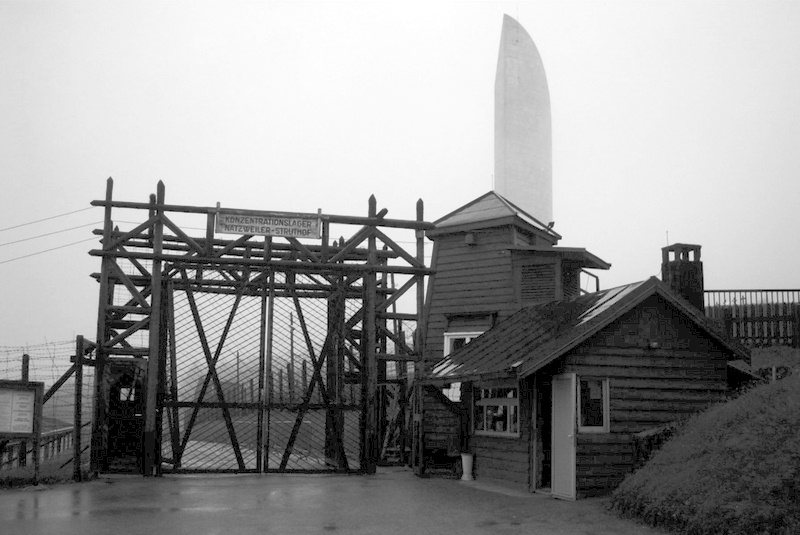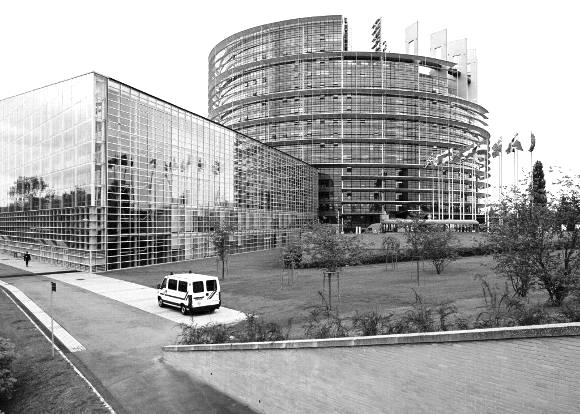
Our day trip to Struthof and Strasbourg
on 16th June 2009
My class level and four teachers, Mrs. Gölz, Mr. Müller, Mr. Klug and Mr. Bergmann, day- tripped to Strasbourg and Struthof on 16th June 2009.
On this trip we learned something about the history of the Concentration Camp Natzweiler- Struthof and about the EU Parliament’s role and tasks in Europe.
I. The Concentration Camp Natzweiler- Struthof

In 1941, the Nazis opened a Concentration Camp near the village Struthof.
This was the only Concentration Camp in France.
In a museum we got lots of information about the Camp’s creation and organisation. We learned that the Jews were not killed by gasification but because they had to work very hard and didn’t get much food and water.
A few people died because they were test persons for some operations.
It was very horrible to hear this because it was a new information for me.
The living conditions for the captives were very bad. They had to sleep in small loft beds and they often were punished if they didn’t work fast enough. If someone tried to flee, he was locked in a small box and had to stay there for some days or even some weeks.
We could see many photos, original objects and scripts of this time inside of some barracks. There was also a short movie with many pictures of the Jews who were arrested in this camp. You saw their sad eyes, how tired and weak they were and how cruel they were treated. No smile on their faces, no hope in their eyes.
I felt very bad during the time we spent in this camp. I stood in front of an original oven in which all dead Jews were burned and it was much more realistic that all those things happened- very different to a normal history lesson when you only talk about it. In this minutes we all were stony- faced, shocked and sad.
II. The EU Parliament

In 1951, the EU Parliament was founded by 6 states, which wanted to avoid that there would ever be a world war again. Since that time more and more states have joined the European Union.
Today the EU Parliament consists of 27 States: Germany, France, Italy, United Kingdom, Spain, Poland, Romania, Netherlands, Belgium, Czech Republic, Greece, Hungary, Portugal, Sweden, Austria, Bulgaria, Finland, Denmark, Slovakia, Ireland, Lithuania, Latvia, Slovenia, Cyprus, Estonia, Luxembourg, Malta.
The number of members in the EU Parliament is proportional to the population of the country. Germany, for example, has the highest number of MEPs with 99 representantives.
During our guided tour through the EU Parliament in Strasbourg we learned a lot about the system of the conferences in the Parliament. We visited two meeting rooms and a guide explained to us how the interpreters’ booths work. We watched a short movie about the history of the Parliament and learned about the challenges of the EU Parliament. Some aims of the states are freedom, respect for human rights and democracy.
We learned about typical symbols of the EU, e.g. about the blue flag with 12 yellow stars. This number stands for unity (like the 12 months and the 12 apostles). The Parliament has the form of a circuit and the atrium has the form of an ellipse. This symbolises that all states have their own traditions and ways of living but all are equal during conferences in the Parliament.
To assure this equality, each representantive can speak in his or her own language. Therefore the interpreters’ booths are needed.
It was most interesting to me to learn about the system of the interpreters’ booths. It was suprising to hear of the many different subject areas that are discussed in the Parliament and that there sometimes are 70 sessions per day.
Julia Spindler
11a